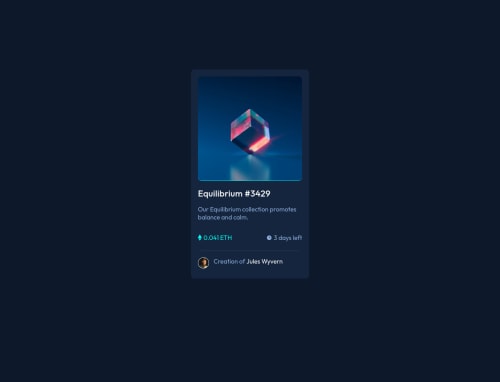CSS Flexbox, HTML Div, HTML Basic, Max Width, Hoverstate, Positioning

Solution retrospective
Hello im Yu from Germany - aspiring Fullstack Web / App Developer. I´m still at the Beginning of my Journey but i have learned alot so far. This is my take on the NFT Card i felt like i did the challenge but in a very clunky way. I would LOVE to get some Feedback on my Code! I would aswell take a look at yours if you want :)
Thank you so much everyone!
Please log in to post a comment
Log in with GitHubCommunity feedback
- @Elir-Mahad
Hey Yu i looked over your code !
It looks clean and not clunky at all.
In your website: https://selfreflective.github.io/NFT-preview-card-component/
There seems to be a horizontal and vertical scroll.
This probably because of the height and width in your body.
I played around with the css and i made some changes to body, .ntf-card, .boxshadow
Implement the below changes to the css classes and let me know what you think.
I identified the css properties that i removed by putting them under 'removed css below' comment.
I identified the css properties that i added by putting them under 'added css below' comment.
body { text-align: center; background-color: hsl(217, 54%, 11%); margin: 0; font-family: Outfit; /* removed css below */ /* width: 1440px; */ /* height: 900px; */ } .ntf-card { border-radius: 10px; background-color: hsl(216, 50%, 16%); width: 340px; /* remove css below */ /* position: relative; */ /* margin: 200px auto; */ /* Added css below */ display:block; margin:auto; margin-top:2rem; } .boxshadow { display: flex; height: 300px; width: 300px; justify-content: center; align-items: center; position: absolute; border-radius: 11px; display: flex; justify-content: center; background-color: hsl(178, 100%, 50%); /* removed css below */ /* margin-bottom: 47px; */ /* bottom: 234px; */ }Also it would be useful, when you are writing out your code, to avoid using position relative and absolute unless its absolutely necessary.
Try using flexbox and margins to move around the page.
Thoughts ?
Marked as helpful
Join our Discord community
Join thousands of Frontend Mentor community members taking the challenges, sharing resources, helping each other, and chatting about all things front-end!
Join our Discord